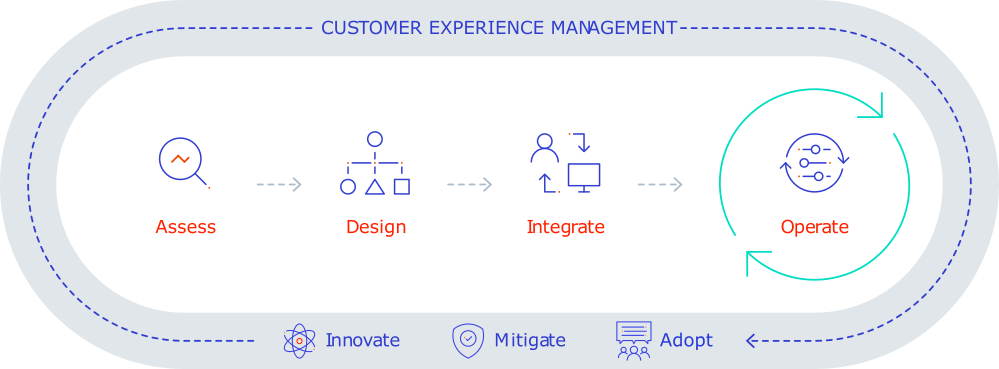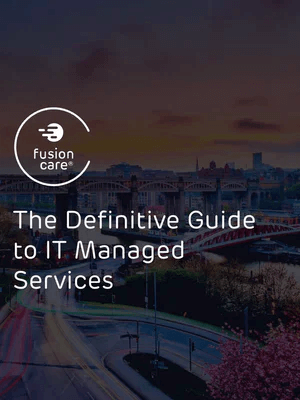


The Definitive Guide to IT Managed Services
In this guide to IT Managed Services, we’ll describe the concept of what it is, why it exists, how the various process outcomes work, and how to use these services to improve the core and context activities within your business.
The Definitive Guide to IT Managed Services
Managed Services relate to outsourcing the responsibility for supporting and anticipating the need for a range of processes and functions to improve operations and reduce internal costs.
A typical Managed Service leverages economy of scale with a Managed Service Provider (MSP) who has the skill, expertise and cost base to provide an essential business service cheaper than a customer organisation can perform where it is not a core activity of their business.
According to Gartner, a managed service provider (MSP) delivers services, such as network, application, infrastructure and security, via ongoing and regular support and active administration on customers’ premises, in their MSP’s data centre (hosting), or in a third-party data centre.
MSPs may deliver their native services in conjunction with other providers’ services. Pure-play MSPs focus on one vendor or technology, usually their own core offerings. Many MSPs include services from other types of providers. The term MSP was traditionally applied to infrastructure or device-centric types of services but has expanded to include continuous, regular management, maintenance and support.
RedHat defines Managed IT Services as the tasks handled by a third party, frequently in the context of business information technology services. The managed services model is a way to offload general tasks to an expert to reduce costs, improve service quality, or free internal teams to do work specific to their business.
What are the common IT service models?
The managed service market is diverse. There is flexibility in how a customer approaches the management of technologies internally or uses a specialist organisation to provide domain-specific services.
Beyond specialised, domain-specific services, it is also possible to implement support via staff-based services. IT support is an especially critical area, as problems of varying severity occur daily. However, it may only be possible to address some of them with your current staff model, or existing solutions need long-term stability and/ or consistency.
This is where Managed IT Support Services are relevant. A basic version of this service, also known as break/fix, is an entry level Managed IT Service. Break/fix services are generally fee-based and reactive. The customer is responsible for contacting the IT services company when repairs and upgrades are needed. While break/fix usually works on a time-and-materials basis in which the contractor charges an hourly rate plus the cost of parts, there are some exceptions. For example, a break/fix company might offer discrete services at a flat rate instead of an hourly rate.
The break/fix model could be beneficial for certain types of organisations where the core activity of the business is not relying on IT completely. There is an increased perception by customers that this model needs to fulfil their requirements when the digital transformation of their businesses is increasing the demand for pro-active support, hence why these organisations are inclined to consumed advanced Managed IT support services across different IT architectures.
Outsourcing is where a company hires a third party to perform tasks, handle operations or provide services.
The hired company, also known as the service provider or a third party, arranges its employees and/ or systems to perform the tasks or services on-site at the hiring company's facilities or external locations.
Companies today can outsource numerous tasks or services; they often outsource information technology services, including programming, application development, and technical support. It is common to outsource customer service and call service functions. Companies can outsource other types of work, including manufacturing processes, human resources tasks and financial functions such as bookkeeping and payroll processing. Companies can outsource entire divisions, such as their IT department or just parts of a particular department.
Outsourcing business functions is sometimes known as contracting out or business process outsourcing. Outsourcing can involve using a sizeable third-party provider or logistics supply chain services. Still, it can also include hiring independent contractors, temporary office workers and freelancers.
Beyond specialised, domain-specific services, it is also possible to implement support via staff-based services. IT support is an especially critical area, as problems of varying severity occur daily. However, it may only be possible to address some of them with your current staff model, or existing solutions need long-term stability and/ or consistency.
This is where Managed IT Support Services are relevant. A basic version of this service, also known as break/fix, is an entry level Managed IT Service. Break/fix services are generally fee-based and reactive. The customer is responsible for contacting the IT services company when repairs and upgrades are needed. While break/fix usually works on a time-and-materials basis in which the contractor charges an hourly rate plus the cost of parts, there are some exceptions. For example, a break/fix company might offer discrete services at a flat rate instead of an hourly rate.
The break/fix model could be beneficial for certain type of organisations where the core activity of the business is not relying on IT completely. There is an increased perception by customers that this model needs to fulfil their requirements when the digital transformation of their businesses is increasing the demand for pro-active support, hence why these organisations are inclined to consumed advanced Managed IT support services across different IT architectures.
Managed IT Services offering
You can find several standard solutions in the IT space that help enable business operations while improving compliance, security, and efficiency. Most of the MSP’s portfolios deliver individual or a combination of services which will have these three areas in common:
Managed IT Service Providers will offer a portfolio of individual or combined services from these three common areas:

With this type of service, a Managed Service Provider generally takes on multiple technology components tasks. There are different architectures the service can manage:
Managed Network
Managed Security
Managed Data Centre and Cloud
Managed Endpoint
Managed Collaboration
As mentioned previously, one of the benefits of adopting a Managed IT Service model is access to skills across different technologies and methodologies. Organisations with small IT teams or lacking technology strategy can rely on the MSP teams to provide guidance and expertise across operational, architectural, and managerial functions. Services that could be available are:
Project Management as a Service
Staff Augmentation
Network and Security Operation Centre
Service Managers
Customer Experience
For the last two decades, companies have consumed technology for their businesses following a model that includes products and the professional services required to design and implement the solution required.
The development of cloud based solutions and the increased consumption of software in enterprise environments are shifting to an “Everything as a Service” model that provides certain benefits from an economical and operational point of view.
Services that can be offered and managed by MSPs are:
Network as a Service
Security as a Service
Collaboration as a Service
Cloud as a Service
Desktop as a Service
How to select the right MSP for you?
If your organisation is interested in investing in a managed provider, it is essential to establish what you need. Understanding what makes a third-party provider a trusted source is critical. No one wants to adopt a long-term plan for crucial elements of business operations and not achieve the desired business objectives.
Here are some characteristics of top-performing managed providers:
The guidance for selecting a Managed IT Service Provider is to understand where the demarcation is, what the customer still wants to retain direct control over and where assistance is required. It needs to be clearly articulated to avoid any misunderstanding, scope creep or expectation gap between the contracting parties, the scope and objective of the Managed Service. Is this to provide substantial savings? Is it a deferral of cost to recognise the additional savings to be made through having a fixed-term contract without any surprises? Customers will not need to invest in new service management software, platforms or reporting tools. No training, development or recruitment. Also, Managed Services provide measurable value in terms of:
The value of an effective MSP is also through knowledge savings. Once they're in the relationship and have thorough knowledge of the customer's infrastructure, they can assist customers with other IT challenges. An effective MSP can help a company transform and scale its IT platform and has IT experts to assist in projects or new technology. Think of it as an extension of the in-house IT team. This partnership will contribute to decrease the risk associated to implementing a new IT solution without following the IT standards of operation adopted by your business. The right MSP will leverage their experience and expertise to identify any cost impact generated by not following the best practices upfront.
Return on Investment (ROI) is a key critical success factor. The simple view is that to have a successful relationship with an MSP, the cost of using the service must be less than the cost of delivering this service to the same standard, utilising internal resources. However, ROI is more complex to calculate as the business environment is constantly evolving. The current state savings should facilitate the change to a managed services provider, but the desired state delivers significant financial benefits. The strength of managed services is really in the management of variation or change, or risk. They bring predictable costs that can flexibly change to meet a customer’s changing requirements, aligned with focusing the customer team on the core business goals.
Customers are reliant on their IT infrastructure for operations; the choice of managed services partner is critical. Pick the wrong provider, and this may have an impact on short-, and long-term plans for business growth.
What characteristics should a customer be looking for in an ideal MSP? A due diligence checklist could contain, from a technical view:
Finally, consider how much it will cost to transfer operations to the Managed Service and the possible ongoing savings. It will provide the opportunity to analyse the net savings. An anticipated outcome will be that it is more productive to utilise existing staff familiar with the business to work on projects that impact business profitability. A common issue when attempting to retain the support and management internally is that the company hire external contractors to deliver projects required to achieve new business goals.
What to expect from your Managed IT Service?
All MSPs will look to satisfy a customer’s basic needs of being able to resolve Incidents and complete basic Moves, Adds, Changes and Deletions (MACDs). Hardware that is found to be faulty or broken will be replaced within the scope of the service. This may be undertaken through Advanced Replacement, where a new part is sent before the faulty is returned. The other option is that a Vendor Warranty may cover the parts, and to have cost optimised, the defective part is returned before being fixed or a replacement shipped to the customer.
Understanding whose responsibility it is for physically undertaking the replacement is key to the agreement. The matter should be determined during service contract negotiations and subsequently defined by scope and demarcations. A key point here is that using the MSP’s staff or subcontractor to perform on-site work will ordinarily incur more cost than simply receiving the parts and being guided by the MSP’s experts.
The most common structure of a modern Managed Service will contain:
Monitoring
MSPs will deploy active and passive monitoring tools. Passive tools will receive information and indicate whether a particular service element, usually a piece of hardware, is working and receiving data or not. This is commonly referred to as up/down monitoring. Active tools are becoming more prevalent as both the hardware and now the applications that traverse the network can be monitored. Having this constant view of the network and the interconnected status’ of elements allows the MSP to be proactive and notice a service degradation before the failure occurs.
Service Management Practices
MSPs will deploy active and passive monitoring tools. Passive tools will receive information and indicate whether a particular service element, usually a piece of hardware, is working and receiving data or not. This is commonly referred to as up/down monitoring. Active tools are becoming more prevalent as both the hardware and now the applications that traverse the network can be monitored. Having this constant view of the network and the interconnected status’ of elements allows the MSP to be proactive and notice a service degradation before the failure occurs.
There are 34 ITIL v4 practices split between General, Service and Technical management practices. The most pertinent practices specific to Managed Services have been mentioned here.
Service Reporting is a key part of IT Managed Services as the MSP needs to demonstrate their operational control of the solution that has been outsourced to them for service. It leads to trends being identified, and where there are repeated or systemic issues, continual service improvements can be highlighted between the MSP and the customer.
Furthermore, the MSP must provide activity reports to show how they perform against agreed SLAs (see below). Customers should also request regular reports that help calculate the value of the service received.
Suggestions include:
Ticket Reporting
SLA Reporting
Performance Monitoring Report
Application Performance
Proactive or Vendor driven activities
Capacity Reporting
MSP will submit strategic recommendations regularly. These recommendations highlight where the solution requires updating beyond the current deployed capability. This can be called Lifecycle Solutions and can be simplistic tracking, or they can utilise a methodology.
Customer Experience Management
Customer experience management (CEM or CXM) refers to the customer's overall experience and dealings with the IT Managed Service supplier. CXM includes numerous facets where customers and suppliers interact. For example, it could focus on proof of concepts (POCs) and, following deployment, consider service features like ease of use, dependability and reliability. In addition, there must be a shared view on how parties responsible for delivery focus their efforts to mould the customer experience. More detail on the topic of CEM or CXM can be found in our related article: What is Customer Experience Management?
The best Managed Service Providers will have the customer experience principles as their DNA, and will use them to manage the lifecycle of the customer IT minimising the gap between the technology and services and the business needs.
Lifecycle Services
Lifecycle Services are the methodologies and practices that support the evolution of technology to business systems and ensures customers get the most return from their IT investments.
The standard phases of a structured Lifecycle Services will be presented in the form of a framework with the following stages:

These services are very pertinent when you want to build a trusted relationship which can be a great benefit when non-standard requests need to be serviced. When the relationship is very transactional and constrained by a very tightly constrained Contract, this is more time consuming and may require specific scoping, quoting, pricing and delivery terms. Having a long-term relationship with an MSP as a Partner to your business helps to build the operational flexibility and agility.
Service Delivery Management
To provide a person to manage the Service relationship between the MSP and the customer, a Service Delivery Manager (SDM) is engaged. This is a service management professional who is ITIL qualified, understands the ITIL based practices and processes used by the MSP and can lead the governance meetings. Historical information is used to build the Service Reports. The SDM provides explanations for the actions that have happened and also the SLA and KPI performance.
SLAs
An MSP will generally offer a standard service level, a four-hour window to fix general support issues for instance. But these SLAs are open to negotiation according to your operating requirements and the strategic importance of the system in question.
The specifics of the SLA will vary between organisations. However, it is not uncommon to have a 15-minute response to incoming calls for support, and a 4-hour fix time, for instance. The quicker you require response and/ or resolution, the more expensive the contract becomes – especially if you want on-site support included.
Before approaching an MSP, you should seriously consider the service you are handing over to your MSP, its importance to your operations, and the maximum time you can tolerate an outage. You are then prepared to negotiate the specific terms of your SLAs.
Other things to discuss when negotiating your contract include your contract period (1, 2, or 3 years), a termination clause, penalties for poor performance and service credits for failing to comply with SLAs.
The SDM will also be a point of escalation during service outages and other activities relating to the service.
The SDM will be the route for consolidating all of the operational feedback. Where there are trends within the types of incidents, they may initiate the problem management process. From the resulting investigation of the root cause, continual service improvement (CSI) actions and recommendations will be made. It is important to understand that some of these may be configuration changes or software updates. In addition, some issues may be lifecycle and supportability related which could require the engagement with the customer success manager to qualify any consulting work, redesign of the solution and a purchase decision by the customer.
Business Outcomes
The selected Managed IT Services provider partnering with your organisation is expected to deliver value by implementing the operational model needed to achieve your business outcomes.
Commonly requested business outcomes, according to organisations, current market and technological trends are described as follows:
Sustainability and Responsibility
Achieve responsible management of technologies and services in line with your Environmental Sustainability Governance policies and control carbon footprint in line with the United Nation’s 2030 Sustainable Development Goals.
Customer and User Experience
Ensure the Managed IT Service offering adopted is in line with your customer satisfaction strategy and is reflected in Net Promoter Scores, customer loyalty and other indications.
Optimisation and Efficiency
Leverage the power of standardisation, analytics and automation whilst combining people, processes, and applications to improve operational efficiency and increase your team productivity.
Security and Compliance
The Managed IT Service provide commits to robust security policies which align with your governance and legislation commitments. Putting the knowledge and expertise of the team at the service of your organisation to reduce risk while enabling innovation through new technologies and services.
Return on Investment
The Managed IT Service provider will offer flexible commercial models to facilitate cost control and predictability while maximise the value delivered through technology and services consolidation, economy of scale, consistency in delivery and team stability.

Book a 30-minute consultation
Transform your business today
Book Consultation
Simply enter your details below and we’ll contact you to arrange your free 30 minute consultation.
